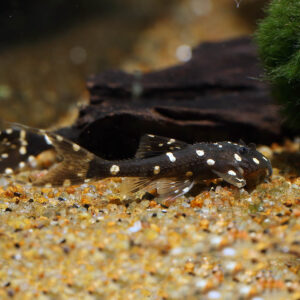Keep Your Eyes Open For Multibuy Livestock Deals:
The family of plecos, scientifically known as Loricariidae, is a diverse group of freshwater fish known for their unique appearance and adaptations. Plecos belong to the order Siluriformes, which includes catfish species. Here’s some information about the pleco family:
Number of Types of Plecos and Genera:
The family Loricariidae consists of numerous species, with over 800 recognized species and counting. These species are classified into various genera, including but not limited to Ancistrus, Hypancistrus, Panaque, Peckoltia, and Hypostomus, among others. Each genus contains multiple species with distinct characteristics and traits.
Smallest Pleco:
The smallest known pleco species is the Bristlenose Catfish (Ancistrus sp.), specifically the Ancistrus cirrhosus, which typically grows to around 3-4 inches (7-10 cm) in length. These small plecos are popular in the aquarium trade due to their manageable size and attractive appearance.
Biggest Pleco:
The largest pleco species is the Plecostomus (Hypostomus plecostomus), also known as the Common Pleco or the Suckermouth Catfish. It can grow to impressive sizes, reaching lengths of up to 24-28 inches (60-70 cm) in the wild. However, in captivity, they generally attain a smaller size, around 12-18 inches (30-45 cm).
Discovery and Taxonomy:
New Loricariidae species are continuously being discovered, and the total number of species within the family Loricariidae is likely to increase in the future. Expeditions to unexplored regions and advancements in genetic analysis have contributed to the ongoing discovery of new pleco species. These discoveries not only enhance our understanding of pleco diversity but also highlight the importance of conserving their natural habitats.
Geographical Distribution:
Loricariidae are native to various regions in South America, predominantly in the Amazon River basin and its surrounding tributaries. They are also found in other river systems across the continent, including the Orinoco, Paraná-Paraguay, and Essequibo rivers. Different species have adapted to specific habitats within these river systems, such as fast-flowing rivers, flooded forests, or rocky riverbeds.
In addition to their natural distribution, plecos have become popular aquarium fish worldwide. Many species are bred in captivity to meet the demand of aquarium enthusiasts, which has led to their introduction and establishment in various regions beyond their native habitats.
Overall, the Loricariidae family offers a remarkable array of species, each with its own unique characteristics, adaptations, and geographical origins. Their diverse range of sizes, appearances, and behaviors make them captivating and sought-after additions to freshwater aquariums.
In stock
In stock
Furunculus Hypancistrus L199
In stock
In stock
Colombian Zebra Pleco L129
In stock
Clown Pleco
In stock
In stock
Butterfly Clown Pleco L168
In stock
Blue Panaque Pleco L239
In stock
In stock
In stock
In stock
Gold Nugget Pleco L081
In stock
In stock
In stock
In stock
In stock
Chubby Pleco
In stock
In stock
In stock
In stock
In stock
Snow White Bristlenose Pleco
In stock
In stock


























